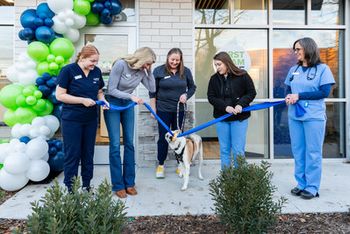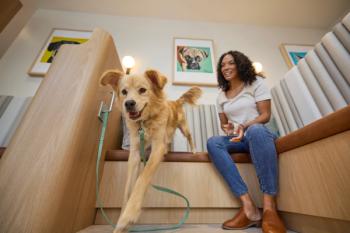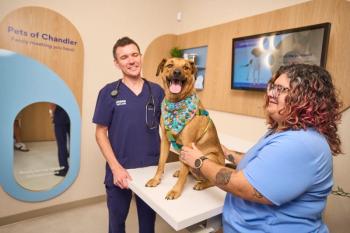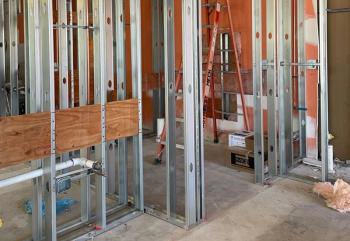
Be a budget-savvy builder-to-be
It's time to face facts. you've spent years dreaming of the perfect veterinary facility, but your pockets are only so deep.
It's time to face facts. You've spent years dreaming of the perfect veterinary facility, but your pockets are only so deep. You can squeeze only so much out of your banker and plan on only so many paying clients to come through the door of your new facility. Are you realizing it's time to cut back on your hospital design budget? Don't worry. Wayne Usiak, AIA, a Veterinary Economics Editorial Advisory Board member, and Paul Gladysz, AIA, both of BDA Architecture in Albuquerque, N.M., help veterinarians affordably realize their dreams. Their advice: Cut where it doesn't count so your blushing bride of a new hospital looks good and works well, but doesn't come with a bankruptcy price tag. Here's where to budget and where to blow it.
Keep high-end flooring in front ...
For client areas, pick an attractive, durable, and stain- and odor-resistant flooring, like that in South Suburban Animal Hospital in Perrysburg, Ohio. It's a porcelain tile with a textured finish and epoxy grout. You want these areas to look nice and be easy to clean. "Pets have accidents, and you don't want a client to feel embarrassed about a mess that's difficult to clean up," Gladysz says.
Photo by Gary Easter
...Cut it in back
Hate the idea of concrete flooring in the back area for you and your staff? Use it anyway. A few years down the line, you can upgrade the floor without inconveniencing clients. "The upgrading process in the back doesn't affect outpatient services at all, and it doesn't impact your practice's image," Usiak says. The sealed concrete floor, above, works well in the runs at Hopi Animal Hospital in Scottsdale, Ariz.
Photo courtesy of BDA Architecture.
Cut ultra-specialized space
An empty room that can be filled with anything you want is a better buy than a specialized room with built-in furniture or equipment. It'll also be easier to upgrade over the years, Usiak says. Check out the easy-to-move furniture at Midwest Vet in Omaha, Neb., right, and the mobile components at Meadow Hills Veterinary Center, left, in Kennewick, Wash. General space is also ideal for leaseholds. "If your dream is to move out one day, remember that you can't take the walls and countertops with you," he says. But you can take modular furniture and equipment.
Photo courtesy of BDA Architecture.
Photo courtesy of BDA Architecture.
Cut curvy walls and excessive detail
Walls with curves are pretty—and expensive. It costs more money to make a curved wall than a straight one. Use rectilinear, traditional forms and details like those at High Point Animal Hospital in Maumee, Ohio. "Your construction costs will be more predictable, and you'll get reliable results," Usiak says.
Photo courtesy of BDA Architecture.
Cut square footage
Site plan by Ralph Thibodeau, AIA.
The quickest way to cut a bulging budget is by shrinking your square footage. But square footage equals revenue. You can't make the money to cover your service debt and new expenses if you don't have exam rooms and treatment areas. So consider which parts of your plan could be added on later. The owners of White Angel Animal Hospital in Austin, Texas, (above) worked with their architect to develop a plan for a kennel that could be added later. Also, as much as you may want a separate room for everything, use dual-purpose rooms whenever possible. If clients won't be bringing in periodontally plagued patients around the clock, do you really need that dental suite? Put your table and equipment in another treatment area that sees occasional duty. "Size reduction is the most significant tool you can use to globally affect your budget," Gladysz says.
Keep high-end lighting in front ...
Put your high-quality lighting where clients will be sure to see it. For staff-only areas, Usiak says there's nothing wrong with simple two-by-four fluorescent drop-down lights. Macungie Animal Hospital (right and below) in Macungie, Pa., transitions from attractive high-end lighting in the lobby to functional, professional-looking fixtures in the hallways.
Photo by Shawnna Vogel.
... Cut it in back
Lighting, like flooring, is easier to upgrade later than many other materials in the hospital. Usiak shakes his head with wonder at some hospital owners' lighting choices. "Why do they have custom lighting in the kennel runs?" he says. "The dogs don't care. They don't go home and tell Dad, 'Hey, we had this fantastic lighting.'"
Photo by Shawnna Vogel.
Cut storage
Many veterinarians harbor storage regrets. "The first thing designers cut when we're over budget is storage," Gladysz says. "But the first thing a veterinarian runs out of is storage." Is the lesson, then, that all the planned storage needs to stay in your design? No way. "Veterinarians forget that they turned that storage space into an eighth exam room because they needed it," Gladysz says. Storage doesn't make money, so stick it where you can fit it. These lockers in the hallway at Oradell Animal Hospital in Paramus, N.J., provide lots of storage without hogging space. You can also streamline your inventory, use vertical spaces, and find other creative ways to keep your team members from tripping over supplies.
Photo courtesy of BDA Architecture.
Keep acoustic and odor control
Hidden above the ceiling and behind the walls of every great hospital are the assets that Usiak guarantees you'll miss if you skimp on them: acoustic control, HVAC, and good insulation. If you go the cheap route, "your hospital will look great, but a year or two down the line, you'll notice that it's really noisy and your kennel staff is wearing headphones," Usiak says. "And you'll find that it starts to stink." To muffle noise and reduce reverberation, use sound-absorbing materials (see unfaced fiberglass in inset photo). HVAC systems don't have to be expensive to be attractive; check out Meadow Hills Veterinary Center's exposed ductwork in the above photo. "This is as much an art as a science," Usiak says.
Photos courtesy of BDA Architecture
You may not want to hear this, but you can't have it all. Usiak breaks this news to his clients up front. "They get seduced by images of $3 million hospitals, but they've only got a $750,000 budget," he says. "We find that clients want the bad news up front. They say, 'Give it to me straight; tell me now.'" You may not be able to afford the Taj Mahal, but on your Big Day you can still cut the ribbons on a clean, attractive, well-built facility that will serve you and your clients for many happy years to come.
Newsletter
From exam room tips to practice management insights, get trusted veterinary news delivered straight to your inbox—subscribe to dvm360.




